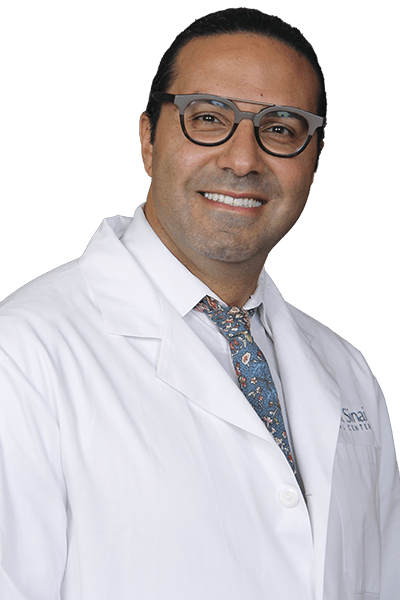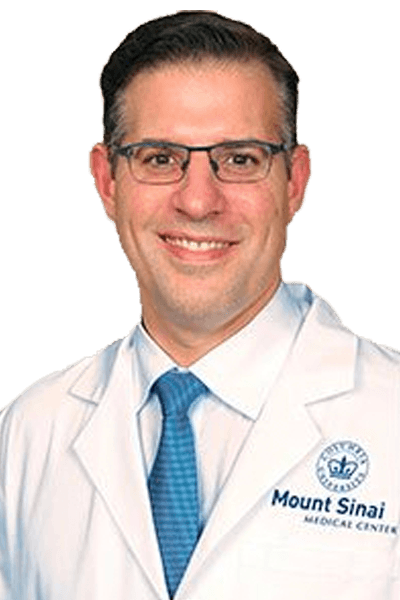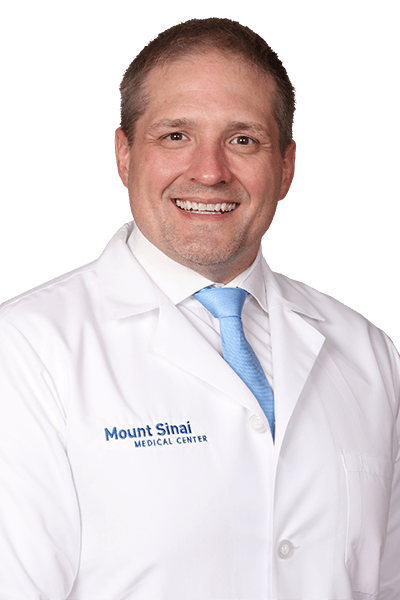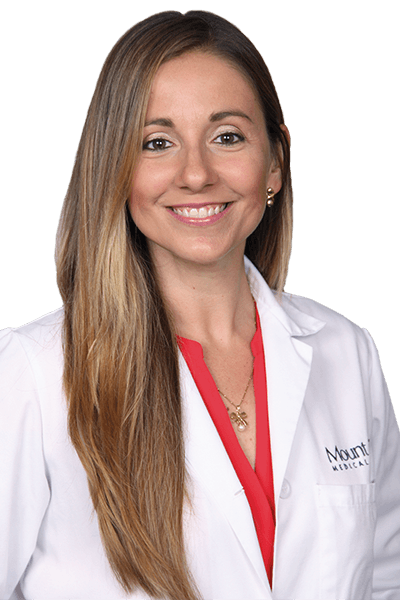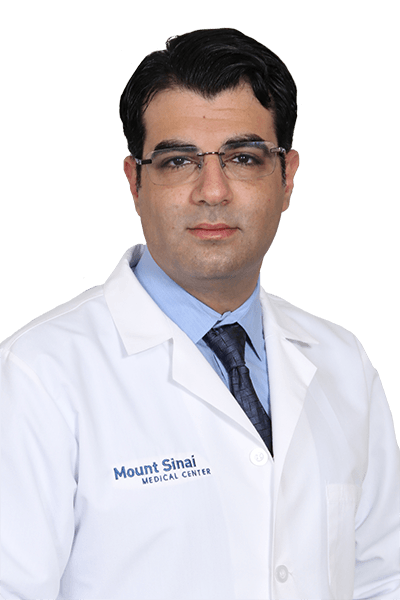Aortic Aneurysm and Dissection
Aneurysms are bulges — almost like balloons — that occur in blood vessels. We do not always know the immediate cause of an aneurysm. But in most cases, pressure from inside the blood vessel pushes against the vessel wall, causing it to stretch beyond its normal width.
Aneurysms are a dangerous condition, because they can burst or tear, and the blood from inside the vessel can spill out of the artery. The larger the artery is, the more dangerous the aneurysm. In fact, aneurysms inside the aorta, which is the largest artery in the body, can be deadly if they burst, rupture, or tear the inner lining of the wall of the aorta (known as an aortic dissection).
While aneurysms can occur in many places in the body, the expert physicians at Mount Sinai’s Aortic Center address aneurysms in the aorta, which is the main artery that carries blood from the heart to the head and neck, all the way down through the abdomen until it splits to bring blood to the legs.
At Mount Sinai’s Aortic Center, each patient receives a complete and personalized care plan that is unique to his or her condition. From coordination of appointments to regular communication with your cardiologist, you can be assured that you are receiving an organized, comprehensive care regimen.
Depending on your specific condition, your care plan may consist of close monitoring at our clinic, without the need for a procedure. Your doctor may recommend regular interval imaging and screenings to determine the status of the condition and follow your condition over time, determining if further intervention is needed in the future.
Treatments
Ascending Aorta Replacement
The ascending portion of the aorta is the part that arches upward from the heart before “turning” downward. When there is a bulge in this part of the aorta, a section of the aorta may need to be replaced. The replacement is done with a surgical procedure that may require a period of approximately 5-6 days in the hospital.
With the best cardiac surgery survival rate in Florida, and expertise performing thousands of ascending aortic replacement surgeries, you can feel confident in the experience and care you are receiving at Mount Sinai.
Valve-Preserving Aortic Root Surgery
When an aneurysm or bulge in the aorta occurs at the part of the aorta that is closest to the heart, the aortic root, the team at Mount Sinai’s Aortic Center may recommend a complex repair approach that preserves the patient’s aortic valve while simultaneously replacing the damaged portion of the aorta with an artificial graft. This routine but complex aortic procedure preserves and repairs the patient’s own valve without the need for valve replacement.
With aortic valve repairs, as opposed to replacement, the patient typically has a higher survival rate and lower risk of needing repeat valve procedures in the future. Mount Sinai is one of only a few centers in Florida to have extensive experience with this procedure, treating a large volume of patients undergoing complex aortic aneurysm repair. And having more experience translates to excellent patient outcomes and lower complication rates.
Composite Aortic Root Replacement (Bentall Procedure)
Composite aortic root replacement, or the Bentall procedure, is a type of repair specifically for aneurysms (or bulges in the wall of the aorta) that occur at the aortic root — the part of the aorta closest to the heart. The procedure replaces the aortic root, ascending aorta, and the aortic valve (unlike a valve-sparing repair that repairs the patient’s own valve). For patients requiring this procedure, the aortic valve typically has irreversible disease (such as calcification, or aortic valve narrowing or severe and longstanding leak).
In some cases, it may even require replacement of the aortic arch, which is the part of the aorta where the artery’s critical vessels branch off to the head and neck and then turn downward to deliver oxygen-rich blood to the abdomen and lower extremities.
Despite its complexity, the surgeons at Mount Sinai’s Aortic Center commonly perform composite aortic root replacement. In fact, we serve as a receiving center for referrals of patients with aortic root aneurysms throughout Florida.
Thoracic Endovascular Aortic Repair (TEVAR)
Thoracic endovascular aortic repair, or TEVAR, treats an aneurysm in the body’s largest artery, the upper part of the aorta. The risk of having the aneurysm burst or rupture, a life-threatening condition, grows as the aneurysm gets bigger. This minimally invasive procedure is completed with only a small cut, or incision, in the patient’s groin. Then, using a catheter, your Mount Sinai aortic expert will use a stent graft, which is a metal tube covered in fabric, to cover and reinforce the aorta to prevent the aneurysm from bursting.
Abdominal Endovascular Aortic Repair (EVAR)
An abdominal endovascular aortic repair, or EVAR, helps repair an aneurysm, which is a bulge or dilation of a blood vessel, at the part of the aorta that runs through the belly area or abdomen. In this minimally invasive procedure, a Mount Sinai surgeon inserts a thin wire, or catheter, into the groin and positions a piece of mesh tube supported by a framework into the aorta, where the aneurysm is. The framework, called a stent, reinforces the aorta and prevents the aneurysm from bursting.
Total Aortic Arch Replacement (TAR)
This procedure is for patients who have aneurysms, or bulges, in the wall of their aorta, at the aortic arch. The aortic arch is the part of the aorta where it turns from aiming upward toward the head to a downward route toward the abdomen and lower extremities. With a total aortic arch replacement, the “great vessels” must be cut to replace the damaged portion of the aortic arch. The great vessels are the major arteries that branch off the aorta and carry blood to the head and neck. After the damaged aortic arch is removed, your expert Mount Sinai surgeon will replace the aortic arch with a special artificial tube (or graft) that has extra “branches” to reconnect the great vessels to the newly repaired aortic arch.
Hybrid Aortic Arch Repair
Hybrid aortic arch repairs are complex surgeries for patients who have large or difficult-to-treat aneurysms, usually at the aortic arch, which is the part of the aorta where it turns from aiming up toward the head to a downward path to deliver blood to the abdomen and lower extremities.
The hybrid approach uses both open-chest surgery along with less-invasive stent replacement (endovascular surgery). In the procedure, your surgeon usually uses an artificial bypass graft, which is a specially made tube that replaces your natural blood vessels. She or he will use the graft to connect the “great vessels” that branch off from the aorta to bring blood to the head and neck. Then, your surgeon will use a large stent graft, which is a fabric tube with a rigid support to reinforce the aorta. The combination of these approaches substantially decreases the associated risks, shortens recovery time, and appreciably decreases the risk of stroke associated with repair of aortic arch aneurysms. The aortic specialists at Mount Sinai Medical Center are experts in these specialized procedures.
Treatment of Penetrating Aortic Ulcer
A penetrating aortic ulcer is an uncommon condition that is caused by a breakdown of the lining of the aorta. It is a life-threatening condition, and treatment is usually required if the ulcer enlarges over time. Treatments will vary, depending on whether the ulcer occurs in the ascending or descending part of the aorta.
Penetrating aortic ulcers in the descending aorta are generally treated with medication to control blood pressure and minimally invasive repair procedures known as thoracic aortic stent grafting. However, if the patient’s ulcer is in the ascending portion of the aorta — that part that aims upward out of the heart toward the head — then open-chest surgery is typically the preferred approach. Regardless of where the ulcer is, these conditions need to be evaluated and sometimes treated emergently or urgently, and the goal is to repair or replace that portion of the aorta that has the penetrating ulcer.
Salvage Aortic Surgery
These surgeries include repair of any previous aortic treatment that has failed. Patients come to the Aortic Center at Mount Sinai for these salvage surgeries because they understand our experts have far-reaching experience and can oftentimes resolve their failed aortic treatments with advanced surgical interventions.
A World of Grafts
Aortic treatment often requires your surgeon to replace a portion of the aorta, as well as portions of arteries that connect to the aorta. The replacement section is called a graft, and it is made of artificial material.
Unlike other medical centers, the Aortic Center at Mount Sinai has access to every graft manufactured and approved for use in humans. With no limitations, Mount Sinai’s surgeons can choose the most appropriate graft for each patient’s specific circumstances and anatomy. In addition, patients have access to the newest grafts, including those currently being tested in clinical trials.
What’s more, at Mount Sinai’s Aortic Center, our team has advanced technology to create custom grafts. Using CT imaging, our technologists build custom grafts that are precisely sized and shaped to the patient’s anatomy. We use these custom grafts to rebuild the aorta and its branches.
Our Physicians
Micheal T Ayad, MD
Chief, Division of Vascular Surgery
Director, Vascular Institute
Co-Director, Aortic Center
- Endovascular Surgery
- Vascular Surgery
- Aortic Aneurysm Repair
- Mount Sinai Medical Center (Main Campus)
- 305.674.2071
- Mount Sinai Emergency Center, Physician Offices, Cancer Center and Diagnostic Center Aventura
- 305.692.1072
- Mount Sinai Specialty Care Key West I Cardiology, Urology & Vascular Care
- 786.584.5555
Steve Xydas, MD
Chief of the Columbia University Division of Cardiac Surgery
Co-Director, Mount Sinai Heart Institute
Co-Director, Aortic Center
- Cardiac Surgery
- Robotic Surgery
- Aortic Aneurysm Repair
- Minimally Invasive Valve Surgery
- Mount Sinai Medical Center (Main Campus)
- 305.674.2121
Steven R DeBeer, MD
Co-Director, Aortic Center
- Cardiac Surgery
- Robotic Surgery
- Thoracic & Cardiovascular Surgery
- Aortic Aneurysm Repair
- Mount Sinai Medical Center (Main Campus)
- 305.674.2121
Sofia Horvath Adam, MD
Assistant Professor of Medicine at the Columbia University Division of Cardiology at Mount Sinai Medical Center
- Cardiology
- Connective Tissue Disease
- Mount Sinai Emergency Center and Primary & Specialty Care Hialeah
- 786.584.5555
Edward Andraos, MD
- Vascular Surgery
- Aortic Aneurysm Repair
- Mount Sinai Medical Center (Main Campus)
- 305.674.2071
- Mount Sinai Emergency Center and Primary & Specialty Care Hialeah
- 786.584.5555
- Mount Sinai Specialty Care Key West I Cardiology, Urology & Vascular Care
- 305.294.8334


